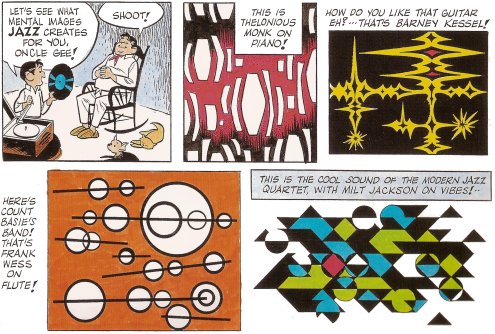
Gordo (comic strip)
Encyclopedia

Comic strip
A comic strip is a sequence of drawings arranged in interrelated panels to display brief humor or form a narrative, often serialized, with text in balloons and captions....
written and drawn by the Mexican-American artist Gustavo "Gus" Arriola
Gus Arriola
Gustavo "Gus" Arriola was a Mexican-American comic strip cartoonist and animator, primarily known for the comic strip Gordo, which ran from 1941 through 1985....
(1917-2008) that introduced many Americans to Mexican culture.
Characters and story
The strip ran from November 24, 1941 to March 2, 1985 and chronicled the life of MexicanMexico
The United Mexican States , commonly known as Mexico , is a federal constitutional republic in North America. It is bordered on the north by the United States; on the south and west by the Pacific Ocean; on the southeast by Guatemala, Belize, and the Caribbean Sea; and on the east by the Gulf of...
bean farmer Perfecto Salazar "Gordo" Lopez ("Gordo" approximately translating as "Fatso"). Other characters in the strip included his nephew, Pepito; his pets, Señor Dog and Poosy Gato (a cat); a black cat named "PM" and her kitten "Bête Noire"; jazz-loving beatnik
Beatnik
Beatnik was a media stereotype of the 1950s and early 1960s that displayed the more superficial aspects of the Beat Generation literary movement of the 1950s and violent film images, along with a cartoonish depiction of the real-life people and the spiritual quest in Jack Kerouac's autobiographical...
spider Bug Rogers, drawn with only six legs; Paris Juarez Keats Garcia, a poet; Artemisa Rosalinda Gonzalez, a widow determined to marry the bachelor farmer; and Tehuana Mama, Gordo's housekeeper.
In 1954, Gordo lost his lease on his land and had to travel throughout Mexico as a tour guide. The character's trips were a vehicle for the strip to introduce Mexico and its people to the wider world. At the height of its popularity the strip appeared in 270 newspapers. The strip was praised by the Mexican Government and the California State Legislature
California State Legislature
The California State Legislature is the state legislature of the U.S. state of California. It is a bicameral body consisting of the lower house, the California State Assembly, with 80 members, and the upper house, the California State Senate, with 40 members...
for its promotion of international understanding.
One of Arriola's trademarks was to use a comic pseudonym for many of his Sunday comic strips, often a phonetic pun of a recognizable word or phrase. Examples include "Kant Wynn" (Can't Win), "Overa Cheever" (Over Achiever), "Anne Teak" (Antique), "Liv Anlern" (Live and Learn), "Bob N. Frapples" (Bobbing For Apples) and "E. Trink and Bea Meri" (Eat, Drink and Be Merry).
Final strip
The final strip ran on March 2, 1985, where in a final effort to avoid the advances of the widow Artemisa Rosalinda Gonzalez, Gordo marries his longtime housekeeper Tehuana Mama. Arriola used three-quarters of the strip to say farewell to his readers.
Sources
- Harvey, R.C. and G. Arriola. 2000. Accidental Ambassador Gordo: The Comic Strip Art of Gus Arriola. University of Mississippi Press. ISBN 1-57806-160-1
- Arriola, Gus. 1981. Gordo's Cat. Oak Tree Publications, Inc. ISBN 0-916392-84-8

